The National Center for the Arts (Cenart), an institution of the Ministry of Culture of the Government of Mexico, welcomes the LGBTIQPA+ Mexico City Gay Choir with a concert of the opera The Death of the Spermatozoids of a Sixty-Foot Forensic Scientist, a daring and irreverent contemporary piece.
With music by Enrique Dunn and dramaturgy by Marta Eguilior, this opera narrates the fall of Analía, a soprano who loses her voice after a performance and plunges into a process of physical and symbolic collapse. Her body becomes the stage for a ritual where death and fertility become blurred until they become impossible.
Through poetic, delirious, and deeply transgressive language, the text describes how her body becomes a territory of transformation, desire, and decomposition. After her death, the coroner, an obsessive and ritual figure, transforms the autopsy into a distorted requiem, an empty fertilization that decrees the definitive death of the sperm, the ultimate symbol of frustrated hope.
The original text is written as a poetic score: repetitions, onomatopoeia, sonic pulses, and delirious fragments that transform words into music. Eguilior, author and director, will perform her own text live during the premiere, giving voice to the written material in a performative reading that inhabits the boundary between speech and song.
The LGBTIQPA+ Mexico City Gay Choir, the collective protagonist of the work, takes on the choral role of the sperm: a multitude of voices that search, collide, die, and are reborn. In their song, one hears both the vital impulse and the impossibility of fertilizing what is already lost. They are the echo of Analía, her memory, her last breath.
The Death of the Sperm of a Sixty-Foot Tall Forensic Scientist is an opera about the loss of song, the desecration of the body, and the beauty that still persists in ruin. It does not seek to represent violence, but rather to transform it into sound, rhythm, and stage truth. It is a ritual of exposure and courage that transforms the wound into art.
An extreme, poetic, and lucid experience that reclaims opera as a territory of risk, thought, and freedom. Because only when song dies does the silence that truly hears us begin.

Source: gob




